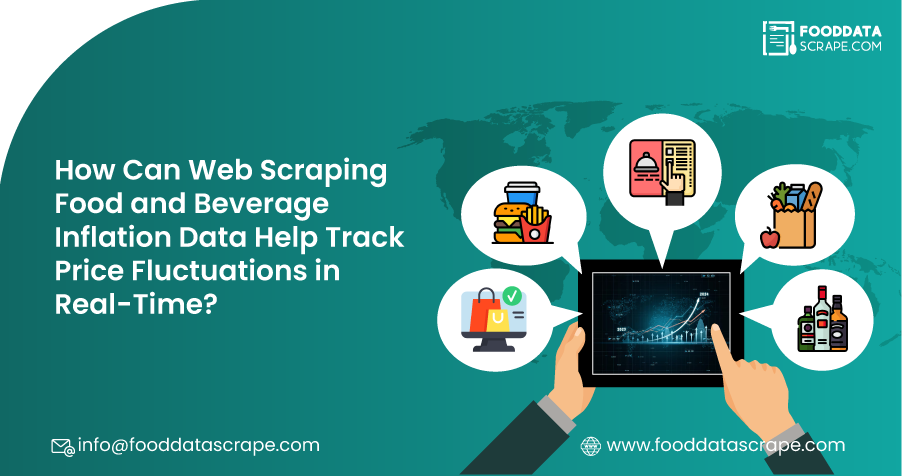Introduction
The increasing food and beverage inflation threatens consumers, companies, and policymakers. With persistent inflation affecting spending power, recognizing price trends in the food and beverage industry is critical. Web Scraping Food and Beverage Inflation Data offers a valuable means of capturing real-time price changes, geographical variations, and impending trends. With the help of automated software to collect information from retail sites, government databases, and market studies, companies can better monitor changes in food prices. The practice enables an understanding of all drivers of price escalation, and it helps companies make better-informed decisions. Scrape Food and Beverage Price Trends from web-based sources can enable companies to shift their pricing plans or recognize issues in supply chains early. Additionally, businesses can Extract Inflation Data from Food Platforms to track how inflation impacts consumer buying behavior and adjust their products and services accordingly.
The Importance of Tracking Food and Beverage Inflation
Food and beverage inflation significantly impacts household budgets, business operations, and economic policy. As the prices of essential staples—such as dairy, meat, grains, and beverages—continue to rise, consumers often adjust their spending habits, opting for more affordable options over variety or premium quality. For businesses, the escalation in input costs can severely squeeze profit margins, prompting the need for adjustments in pricing strategies or even sourcing methods. Governments and central banks closely monitor inflation data to guide monetary policies and stabilize the broader economy.
Traditional inflation tracking methods, such as Consumer Price Index (CPI) reports, tend to be outdated and lag behind current market conditions. In contrast, Scrape F&B Pricing for Inflation Insights through web scraping offers a real-time, granular view of food and beverage prices across various platforms. By Scraping Real-Time Food & Beverage Price Changes from e-commerce sites, grocery chains, and public datasets, businesses, and policymakers gain immediate access to up-to-date pricing trends. This allows stakeholders to make more informed decisions promptly. For example, retailers can use scraped data to adjust their pricing strategies quickly in response to price fluctuations. At the same time, policymakers can assess the effects of supply chain disruptions or shifting demand on food costs. Moreover, Web Scraping Inflation Data for the F&B Industry ensures that businesses stay competitive while adapting to the volatile market conditions caused by inflation.
How Web Scraping Works for Inflation Data?
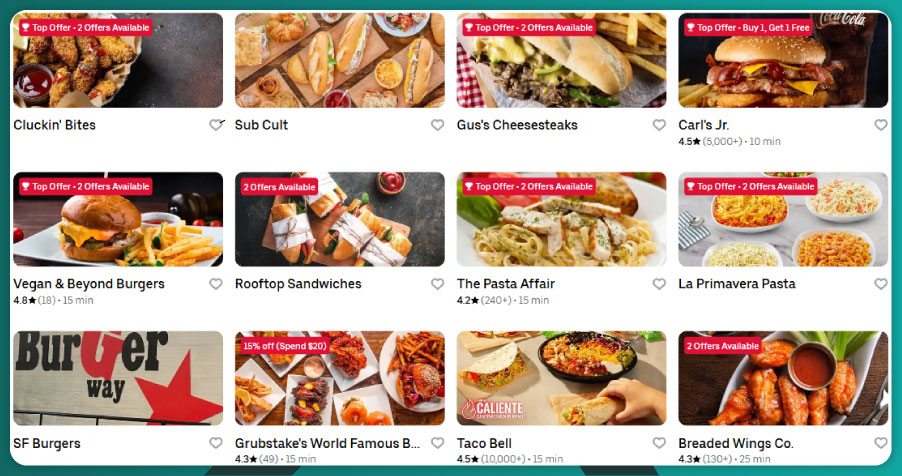
Web scraping involves using software tools to collect data from websites. Regarding food and beverage inflation, scrapers target sources like online grocery stores, restaurant menus, or government portals that publish price indices. These tools navigate web pages, identify relevant data points—such as product prices, categories, or availability—and store them in structured formats like CSV or JSON for analysis.
Key aspects of web scraping for inflation data include:
- Targeted Data Extraction: Scrapers visit websites like supermarkets or e-commerce platforms to collect prices for specific items, such as milk, bread, or eggs, along with details like brand and package size. This approach is also used for Food Delivery Data Scraping Services , ensuring accurate price tracking across food delivery platforms.
- Automation and Scale: By automating data collection across multiple retailers and regions, scrapers efficiently build comprehensive datasets of price trends, which is especially useful in Restaurant Menu Data Scraping for tracking dish prices in various locations.
- Handling Dynamic Content: Advanced scrapers manage JavaScript-heavy websites, ensuring access to real-time data that reflects current market conditions, including data from Food Delivery Scraping API Services that dynamically track price changes and menu adjustments.
- Data Structuring: Extracted data is organized into formats suitable for analysis, enabling stakeholders to track price changes over time. This structured approach also supports Restaurant Data Intelligence Services , empowering businesses to make data-driven decisions.
This automated approach saves time and provides a level of detail that manual data collection cannot match.
Unlock valuable beverage market insights today—contact us to start scraping real-time data for more intelligent business decisions!
Key Sources for Food and Beverage Price Data
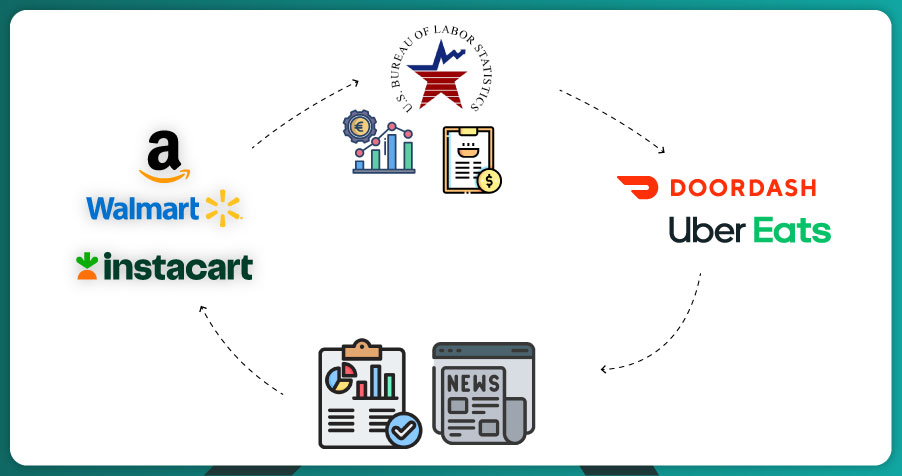
The internet offers a wealth of sources for scraping food and beverage inflation data. These include:
- E-commerce Platforms: Sites like Amazon, Walmart, and Instacart list prices for thousands of products, often with metadata like customer reviews or stock levels to contextualize price changes.
- Government Websites: Agencies such as the U.S. Bureau of Labor Statistics (BLS) or Eurostat provide CPI data, food price indices, and commodity reports as benchmarks for validating scraped data.
- Regional Retailers and Delivery Services: Local grocery chains and platforms like DoorDash or Uber Eats offer localized price data, which is crucial for analyzing geographic variations in inflation.
- Market Reports and News Outlets: Reports from research firms or news sites provide insights into inflation drivers, such as crop failures or energy cost increases.
Analysts can create a holistic view of price dynamics in the food and beverage sector by combining data from these sources.
Applications in Consumer Behavior Analysis
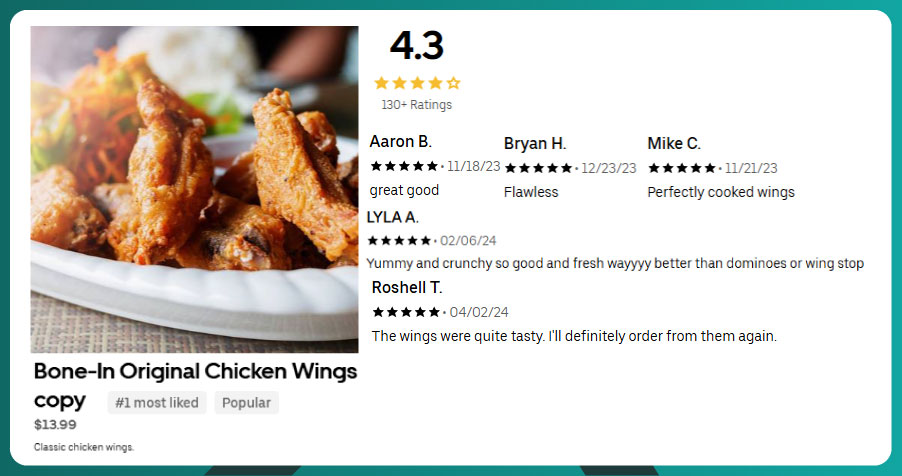
Web-scraped inflation data shows how consumers respond to rising food and beverage prices. By analyzing price trends alongside sales volumes or search queries, businesses can gauge shifts in demand. For example, if scraped data shows a steady increase in chicken prices, retailers might notice a corresponding demand for cheaper alternatives like plant-based proteins.
Applications in consumer behavior analysis include:
- Tracking Price Sensitivity: Scraped data reveals how demographics, such as urban versus rural shoppers, respond to price changes for items like organic produce or budget staples.
- Monitoring Purchasing Patterns: Data from loyalty programs or online carts highlights trends like bulk buying during rapid inflation, informing inventory strategies.
- Optimizing Product Offerings: Retailers use insights to tailor promotions or introduce value-oriented products to retain customers.
- Ingredient Cost Management: Food manufacturers track prices of raw materials like flour or sugar to adjust production or reformulate recipes with cost-effective substitutes.
These insights enable businesses to adapt to shifting consumer preferences and mitigate the impact of inflation.
Supporting Policy and Economic Research

Web scraping empowers policymakers and researchers to study food and beverage inflation more precisely. Real-time price data complements official statistics, revealing short-term trends that monthly reports might miss. For instance, scraped data could highlight a sudden surge in dairy prices due to a regional heatwave, prompting targeted subsidies or import adjustments. Key contributions to policy and research include:
- Informing Monetary Policy: Central banks use real-time data to assess whether food price increases are transitory or structural, guiding interest rate decisions.
- Enhancing Food Security: Scraped data identifies regions where staple goods are becoming unaffordable, supporting targeted interventions like food assistance programs.
- Supporting Academic Studies: Researchers combine price data with income statistics to analyze inflation’s socioeconomic impacts, such as its effects on low-income households.
- Validating Official Data: Scraped datasets provide a real-time check against aggregated government reports, improving the accuracy of economic models.
These applications help shape policies that address inflation’s broader impacts.
Enabling Competitive Analysis for Businesses
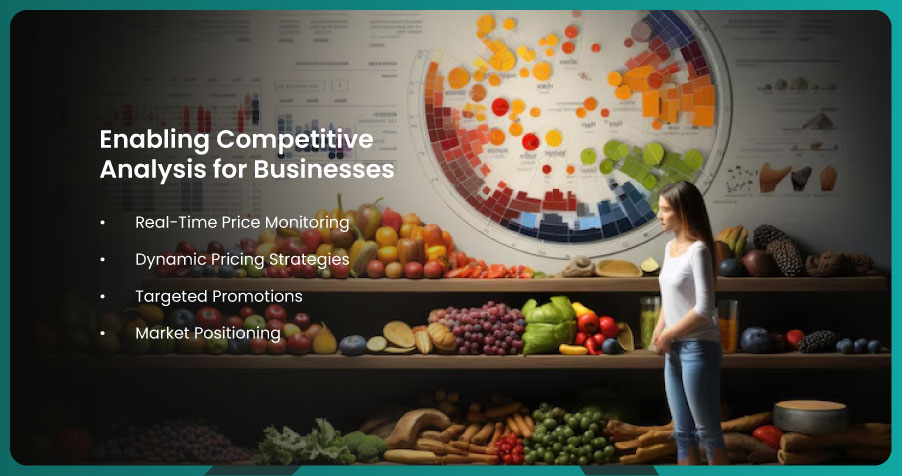
TIn the food and beverage industry, staying competitive requires constant monitoring of market conditions. Web scraping allows businesses to track competitors’ pricing strategies in real-time. A restaurant chain, for instance, might scrape menu prices from rival establishments to ensure its offerings remain attractive. Similarly, a grocery store could monitor competitors’ discounts on high-demand items like meat or produce.
- Real-Time Price Monitoring: Businesses track competitors’ pricing for similar products, ensuring their prices remain competitive.
- Dynamic Pricing Strategies: Companies adjust markups to balance profitability and customer retention by analyzing scraped prices alongside supply chain costs.
- Targeted Promotions: Retailers respond to competitors’ discounts with strategic promotions to maintain market share.
- Market Positioning: Scraped data helps businesses identify opportunities to differentiate their offerings, such as emphasizing quality or affordability.
Scraped data thus equips businesses to navigate inflationary pressures while maintaining a competitive edge.
How Food Data Scrape Can Help You?
- Real-Time Price Tracking: We can scrape data from e-commerce platforms and grocery stores to monitor beverage prices, helping businesses adjust their pricing strategies promptly.
- Trend Analysis: By scraping social media, online reviews, and blogs, we can identify emerging beverage trends, allowing brands to stay ahead of consumer preferences.
- Menu Data Extraction: We provide Restaurant Menu Data Scraping services, collecting beverage offerings, prices, and promotions from restaurant menus to support competitive analysis.
- Market Insights: Using Food Delivery Datasets, we can gather data on beverage sales, popularity, and regional preferences, helping brands make data-driven decisions on product launches.
- Inventory and Stock Monitoring: We assist in scraping beverage availability data from multiple sources, enabling businesses to optimize stock levels and manage inventory effectively.
Conclusion
Web scraping has emerged as a transformative tool for understanding food and beverage inflation, offering real-time insights that traditional methods cannot match. Extracting detailed price data from diverse online sources empowers consumers, businesses, and policymakers to make informed decisions in a rapidly changing economic landscape. Retailers can optimize pricing and inventory, manufacturers can manage costs, and governments can craft targeted policies to mitigate inflation’s impact. For instance, Food Delivery Intelligence Services can help businesses track price changes across various platforms, providing a competitive edge in adjusting their strategies. Additionally, a Food Price Dashboard can be built to visualize and analyze trends, enabling real-time decision-making. As food prices fluctuate, the ability to monitor these shifts through Food Delivery Datasets ensures businesses and stakeholders can stay proactive, fostering resilience and adaptability in an inflationary world. Web scraping will continue to be crucial in navigating challenges and seizing opportunities in this dynamic sector.
If you are seeking for a reliable data scraping services, Food Data Scrape is at your service. We hold prominence in Food Data Aggregator and Mobile Restaurant App Scraping with impeccable data analysis for strategic decision-making.

















































































